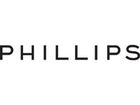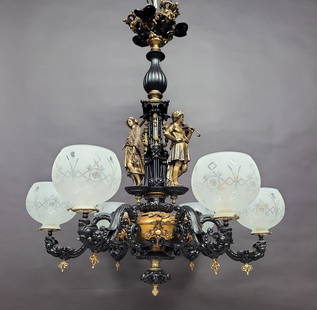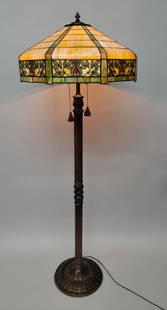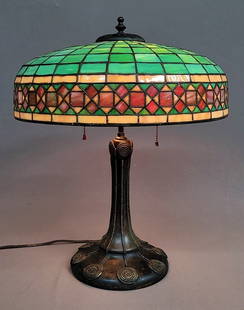
ROY LICHTENSTEIN, Still Life with Cash Box, 1976
Similar Sale History
View More Items in Desk Lamps

Related Desk Lamps
More Items in Desk Lamps
View MoreRecommended Lighting
View More


Item Details
Description
Still Life with Cash Box, 1976. oil and Magna on canvas 70 1/8 x 54 1/8 in. (178.1 x 137.5 cm) Signed and dated “rf Lichtenstein '76” on the reverseΟ
PROVENANCE Leo Castelli Gallery, New York Waddington Galleries, London Private collection, London James Goodman Gallery, New York Collection of Betty Freeman Private Collection
EXHIBITED Chicago, Richard Gray Gallery, Roy Lichtenstein: New Still Lifes, January 14 - February 1977 San Francisco, Fine Arts Museum, The Work Show, September 9 - November 11, 1978 New York, Gagosian Gallery, Roy Lichtenstein: Still Lifes, May 8 - July 30, 2010
LITERATURE F. Schulze, “Pop Art Without Zowie: Lichtenstein’s New Cool,” Panorama-Chicago Daily News, February 5-6, 1977, p. 12 (illustrated) S. Ratibor, Roy Lichtenstein: Still Lifes, New York, Gagosian Gallery, 2010, pp. 182-183 (illustrated)
All my art is in some way about other art, even if the other art is cartoons. ROY LICHTENSTEIN (Roy Lichtenstein, quoted in J. Hendrickson, Roy Lichtenstein, Cologne 2000, frontispiece). Roy Lichtenstein’s still lifes of the 1970s and early 1980s mark not only a new direction for the Pop master, but also an innovative transformation of the historical genre itself. Appropriating subjects from the highly respected tradition of Seventeenth Century still life painting, Lichtenstein updated the compositions with his best known style: signature primary colors, bold lines, and simulated Ben-Day dots. Lichtenstein used postcards and reproductions of original works in creating his own unique versions, rendering his still lifes in outlined shapes and blocks of color inspired by monochromatic newspaper and print advertisements. Painted in 1976, the present lot, Still Life with Cash Box, is from the series Office Still Lifes that deliberately capture the mundane palettes and objects of corporate interiors. The chairs, shades, lamps, and various containers are sourced from clipping fragments of office-supply and mail-order catalogues. Through this full panoply of office equipment and accessories, Lichtenstein discovers a fertile foundation for the intervention of commercial art. While the subject matter is perversely prosaic, Lichtenstein brilliantly overcomes its mundanity through his abstractions and visual exploration of the mechanics of everyday objects. In Still Life with Cash Box, 1976, the lines and blocks of color which define Lichtenstein’s style, are pushed to an extreme, evocative of Op Art or Minimalism as much as Pop. Rendered in a restrained color palette of grays, blues, and whites, an empty titular cash box sits opened, precariously close to the edge of the desk. Beside it lies a folded newspaper, and above, an erect desk lamp. In the background of the composition, a series of equidistant parallel lines creates a group of lockers and a gigantic window, through which no exterior or outdoors is visible. The surface of the desk, blanketed in blue lines, extends to the far corner of the room, blurring the edges of the floor, wall, and furniture. All the lines are stridently rigid, except for three vertical bands to the left of canvas, which undulate to capture the movement of drapes. The present lot is purely an interior, with no hint at an outside world; simple lines comprise dimension, shadow, and depth. Lichtenstein’s still lifes from the 1970s is a prolific body of remarkably imaginative works. This energized and productive direction pushed beyond the now-canonical paintings of the 1960s. In his rejuvenated exploration of parallel lines, Lichtenstein played with the concepts of gradation, shadow and depth, as witnessed in the pools of lines across the many surfaces of Still Life with Cash Box, 1976. Sections of closely knit bands, evocative of the wispy strokes of a lead pencil, create the illusion of shadow on a two-dimensional surface; we see these pools on the surfaces of the lockers, newspaper, window panes, and interior of the cash box. These movements, as well as the limited color palette, truly capture the craft and skill inherent in preparatory drawings. When compared to the sketch of the present lot, rendered in thick green felttip pen and lead pencil, the strokes which seem natural in their respective mediums, are not only preparatory, but indicative of the painting that is to be completed. Lichtenstein then employs the mechanics of the technique with oil and Magna. The adaptation of the tradition of still life painting was embraced by almost the entire Pop Generation. In a cohesive moment, around 1959-1960, and during the decade that followed, the Pop icons established their signature styles and the character of the entire movement. Tom Wesselmann, Robert Indiana, Claes Oldenburg, and Andy Warhol, amongst others, were all linked together under the Pop rubric for the resurrection and celebration of commercial and advertising imagery. At the core of this faction, however, was Roy Lichtenstein, who most vividly and buoyantly embraced the idiosyncrasies of the movement and made them entirely his own through his witty spirit and clever style. While Lichtenstein found his fame through the renowned comic-book paintings, he continued to evolve his subject matter while maintaining the patterns appropriated from magazine and newspaper images. The Still Lifes marked a significant departure from his paintings of soap-opera and teenromance females, as well as war-comic scenes; however, household objects were evident in some of the artist’s formative works, including Cherry Pie, Turkey, Hot Dog, and Ice Cream Soda, all conceived between 1961 and 1963. Other works, like Black Flowers, 1961, reappeared as part of larger tabletop compositions. Aside from celebrating the historical tradition of still lifes, Lichtenstein simultaneously called upon his forebears. As homage to art and Old Master painters, Lichtenstein reinterpreted the hallowed traditions of genre painting, calling upon the pictures of Pablo Picasso, Henri Matisse, and Giorgio Morandi. But it was the still lifes that served as a larger investigation of art subjects, one that was far reaching and adventurous in its reinterpretations of the masters. Evident in Still Life with Cash Box, 1976, Lichtenstein borrowed many formal elements from the masters who preceded him. In Pablo Picasso’s Still Life with a Lamp, 1936, a tabletop is bedecked in everyday objects—a pitcher, a bowl of fruit, and a serviette—all illuminated by a single bare light bulb which hangs from above. In his Office Series, Lichtenstein adopted the technique of depicting strewn about objects in a casually and natural environment. The composition offers a glimpse into the ordinary and everyday interior. Additionally, the positioning and cropping of the table, as well as the fragmented background of the present lot, seem very much inspired by Picasso’s Cubist painting. Lichtenstein embraces his modern sources by combining the process of fragmentation and assemblage, with modern subject matter. Instead of employing household objects, he selects the props of a banal businesslike atmosphere, bringing the still life into commercial Modernity. Lichtenstein also brilliantly hints at an implied narrative within the seemingly mundane interior. While objects seem casually presented, our imaginations might lead us to suspect foul-play in the open and empty cash box upon the desk. Even the deliberately restrained palette, based on the minimal means of the drawing itself, adds a cinematic atmosphere to the office. The viewer, however, has arrived too late. The contents of the box are long gone, as the billowing curtains indicate the escape route taken by the thief. While the assemblage of objects is stagnant, the precariously placed cashbox, the ripple of the curtains, and the shadows cast across the objects, evoke supreme movements, activating the interior with life.
PROVENANCE Leo Castelli Gallery, New York Waddington Galleries, London Private collection, London James Goodman Gallery, New York Collection of Betty Freeman Private Collection
EXHIBITED Chicago, Richard Gray Gallery, Roy Lichtenstein: New Still Lifes, January 14 - February 1977 San Francisco, Fine Arts Museum, The Work Show, September 9 - November 11, 1978 New York, Gagosian Gallery, Roy Lichtenstein: Still Lifes, May 8 - July 30, 2010
LITERATURE F. Schulze, “Pop Art Without Zowie: Lichtenstein’s New Cool,” Panorama-Chicago Daily News, February 5-6, 1977, p. 12 (illustrated) S. Ratibor, Roy Lichtenstein: Still Lifes, New York, Gagosian Gallery, 2010, pp. 182-183 (illustrated)
All my art is in some way about other art, even if the other art is cartoons. ROY LICHTENSTEIN (Roy Lichtenstein, quoted in J. Hendrickson, Roy Lichtenstein, Cologne 2000, frontispiece). Roy Lichtenstein’s still lifes of the 1970s and early 1980s mark not only a new direction for the Pop master, but also an innovative transformation of the historical genre itself. Appropriating subjects from the highly respected tradition of Seventeenth Century still life painting, Lichtenstein updated the compositions with his best known style: signature primary colors, bold lines, and simulated Ben-Day dots. Lichtenstein used postcards and reproductions of original works in creating his own unique versions, rendering his still lifes in outlined shapes and blocks of color inspired by monochromatic newspaper and print advertisements. Painted in 1976, the present lot, Still Life with Cash Box, is from the series Office Still Lifes that deliberately capture the mundane palettes and objects of corporate interiors. The chairs, shades, lamps, and various containers are sourced from clipping fragments of office-supply and mail-order catalogues. Through this full panoply of office equipment and accessories, Lichtenstein discovers a fertile foundation for the intervention of commercial art. While the subject matter is perversely prosaic, Lichtenstein brilliantly overcomes its mundanity through his abstractions and visual exploration of the mechanics of everyday objects. In Still Life with Cash Box, 1976, the lines and blocks of color which define Lichtenstein’s style, are pushed to an extreme, evocative of Op Art or Minimalism as much as Pop. Rendered in a restrained color palette of grays, blues, and whites, an empty titular cash box sits opened, precariously close to the edge of the desk. Beside it lies a folded newspaper, and above, an erect desk lamp. In the background of the composition, a series of equidistant parallel lines creates a group of lockers and a gigantic window, through which no exterior or outdoors is visible. The surface of the desk, blanketed in blue lines, extends to the far corner of the room, blurring the edges of the floor, wall, and furniture. All the lines are stridently rigid, except for three vertical bands to the left of canvas, which undulate to capture the movement of drapes. The present lot is purely an interior, with no hint at an outside world; simple lines comprise dimension, shadow, and depth. Lichtenstein’s still lifes from the 1970s is a prolific body of remarkably imaginative works. This energized and productive direction pushed beyond the now-canonical paintings of the 1960s. In his rejuvenated exploration of parallel lines, Lichtenstein played with the concepts of gradation, shadow and depth, as witnessed in the pools of lines across the many surfaces of Still Life with Cash Box, 1976. Sections of closely knit bands, evocative of the wispy strokes of a lead pencil, create the illusion of shadow on a two-dimensional surface; we see these pools on the surfaces of the lockers, newspaper, window panes, and interior of the cash box. These movements, as well as the limited color palette, truly capture the craft and skill inherent in preparatory drawings. When compared to the sketch of the present lot, rendered in thick green felttip pen and lead pencil, the strokes which seem natural in their respective mediums, are not only preparatory, but indicative of the painting that is to be completed. Lichtenstein then employs the mechanics of the technique with oil and Magna. The adaptation of the tradition of still life painting was embraced by almost the entire Pop Generation. In a cohesive moment, around 1959-1960, and during the decade that followed, the Pop icons established their signature styles and the character of the entire movement. Tom Wesselmann, Robert Indiana, Claes Oldenburg, and Andy Warhol, amongst others, were all linked together under the Pop rubric for the resurrection and celebration of commercial and advertising imagery. At the core of this faction, however, was Roy Lichtenstein, who most vividly and buoyantly embraced the idiosyncrasies of the movement and made them entirely his own through his witty spirit and clever style. While Lichtenstein found his fame through the renowned comic-book paintings, he continued to evolve his subject matter while maintaining the patterns appropriated from magazine and newspaper images. The Still Lifes marked a significant departure from his paintings of soap-opera and teenromance females, as well as war-comic scenes; however, household objects were evident in some of the artist’s formative works, including Cherry Pie, Turkey, Hot Dog, and Ice Cream Soda, all conceived between 1961 and 1963. Other works, like Black Flowers, 1961, reappeared as part of larger tabletop compositions. Aside from celebrating the historical tradition of still lifes, Lichtenstein simultaneously called upon his forebears. As homage to art and Old Master painters, Lichtenstein reinterpreted the hallowed traditions of genre painting, calling upon the pictures of Pablo Picasso, Henri Matisse, and Giorgio Morandi. But it was the still lifes that served as a larger investigation of art subjects, one that was far reaching and adventurous in its reinterpretations of the masters. Evident in Still Life with Cash Box, 1976, Lichtenstein borrowed many formal elements from the masters who preceded him. In Pablo Picasso’s Still Life with a Lamp, 1936, a tabletop is bedecked in everyday objects—a pitcher, a bowl of fruit, and a serviette—all illuminated by a single bare light bulb which hangs from above. In his Office Series, Lichtenstein adopted the technique of depicting strewn about objects in a casually and natural environment. The composition offers a glimpse into the ordinary and everyday interior. Additionally, the positioning and cropping of the table, as well as the fragmented background of the present lot, seem very much inspired by Picasso’s Cubist painting. Lichtenstein embraces his modern sources by combining the process of fragmentation and assemblage, with modern subject matter. Instead of employing household objects, he selects the props of a banal businesslike atmosphere, bringing the still life into commercial Modernity. Lichtenstein also brilliantly hints at an implied narrative within the seemingly mundane interior. While objects seem casually presented, our imaginations might lead us to suspect foul-play in the open and empty cash box upon the desk. Even the deliberately restrained palette, based on the minimal means of the drawing itself, adds a cinematic atmosphere to the office. The viewer, however, has arrived too late. The contents of the box are long gone, as the billowing curtains indicate the escape route taken by the thief. While the assemblage of objects is stagnant, the precariously placed cashbox, the ripple of the curtains, and the shadows cast across the objects, evoke supreme movements, activating the interior with life.
Buyer's Premium
- 25% up to $50,000.00
- 20% up to $1,000,000.00
- 12% above $1,000,000.00
ROY LICHTENSTEIN, Still Life with Cash Box, 1976
Estimate $3,000,000 - $5,000,000
8 bidders are watching this item.
Shipping & Pickup Options
Item located in New York, NY, usSee Policy for Shipping
Payment

Related Searches
TOP






























































